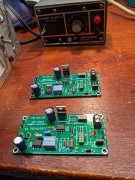J!m
Veteran and General Yakker
Or, you use both sets of contacts (in parallel) so you are running half the amperage per contact set.
Yes, the accessory power jacks should be used to connect to equipment that is already fused internally. Otherwise, you have a fuse protecting a fuse! If the PL2000 1/8th Amp fuse blows, only the preamplifier shuts down. If you wanted to fuse the accessory jacks with a single fuse, it would have to be rated at 7 Amps, which the PL2000 would never blow!The accessory power plugs need to be fused separately from the preamp if they're to be kept active.

It's a ugly little bugger!What a cute transformer!

Not sure why you have 2 hot un-switched wires running forward to the switch?I shortened the wire runs about 27", dressed them away from the circuit board, twisted the AC pair, wired the fuse (correctly) and before the switch, and gave myself another (low wattage) switched accessory jack.
View attachment 54203
I did not change the PL power switch wiring scheme. My color coding is as follows:Not sure why you have 2 hot un-switched wires running forward to the switch?






